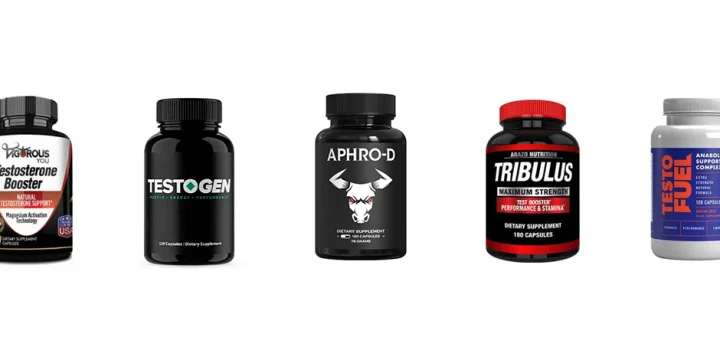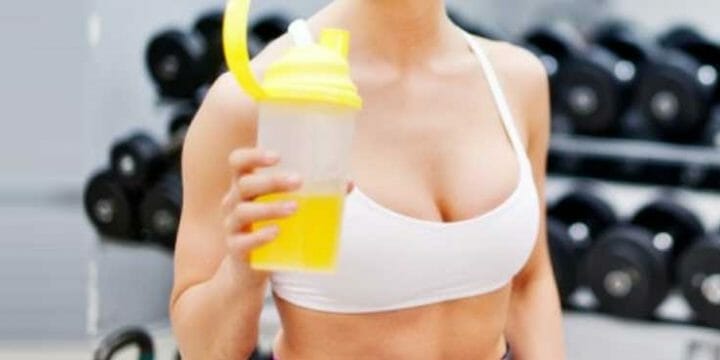Most ladies think that strength training is specifically meant for men. Well, that is an outdated myth. There are strength training workout routines that women can comfortably do without straining.
Strength training, also sometimes referred to as resistance training or weight lifting, is so beneficial. It keeps your body fit, and helps in shedding off some unwanted calories.
Strength training for women has given numerous ladies a new look, which no one ever imagined. You simply need to be consistent in your workout routines and also eat a healthy diet.
Quick Summary
- Deadlifts, squats, leg presses, lunges, bench presses, leg presses, rows, and plank holds are examples of strength training for women worth trying out.
- Strength training for women increases your overall strength and endurance and boosts your energy levels.
- According to the National Institutes of Health, strength training significantly increases women's strength and improves body composition within a few months.
- In my opinion, strength training is an empowering and beneficial practice for women, effectively challenging the outdated notion that it's predominantly for men.
Strength Training Exercises for Women
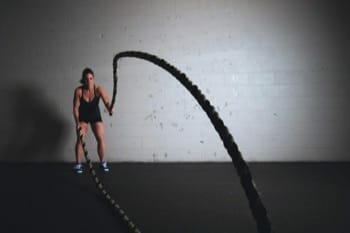
According to insights from a study published by the National Institutes of Health (NIH), compound exercises are a combination of two or more exercises, focusing on different muscle groups. These can be useful for women looking to increase their muscular strength [1].
The more muscle fibers you work at any given instant, the stronger you will get and the higher your metabolic response will be.
Let’s go over the primary compound exercises that you should be focusing on in your workout routine. Add these and you will be on track to seeing optimal results.
1. Squats
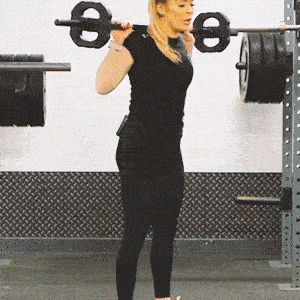
It simply doesn’t get better than the squat. Unless an injury prohibits you, you should be squatting. This single exercise works so many muscle groups at once, developing your thighs, hips and booty.
Note that there are so many squat variations to the squat you can perform including back squats, low bar squats, front squats, sumo squats, bodyweight squats, jump squats, as well as prisoner squats.
Muscles utilized: Quads, Hamstrings, Glutes, Calves, Lower Back, Upper Back, Core
How-To
- Stand up straight with your feet shoulder-width apart and extend your hands straight out in front of you for balance.
- Start to sit down as you would into a chair, but keep your head facing forward as your upper body slightly bends forward.
- Your lower back will arch slightly, don't allow your back to become rounded.
- Try to make your thighs parallel with the floor as your legs remain fairly straight.
- Keep your core tightened as you stand back up by pushing through your heels, and repeat.
2. Deadlifts
Deadlifts are excellent for helping you build superior lower back strength and will also work the posterior chain muscles as well (glutes and hamstrings).
You can either do stiff legged deadlifts where the knees don’t bend at all or traditional deadlifts, where you maintain a slight bend in the knee.
Bending the knee will put a bit more emphasis on the quads as well as the back muscles, while keeping the knee straight will take the quads out of the picture.
Muscles utilized: Glutes, Hamstrings, Calves, Core, Lower Back
How-To
- Stand with a barbell in front of the feet in an upright position, feet about hip width apart.
- Bend over, bending the knees as you do while keeping the back flat.
- Once at 90 degrees, reach forward and place both hands on the barbell.
- Press up, keeping the back flat as you resume a standing position and lift the weight off the ground.
- Pause at the top before lowering the weight to the ground to complete the rep.
3. Lunges
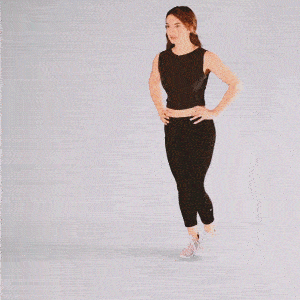
Lunges are another good leg exercise to be adding to your routine and will really hit those lower body muscles allowing you to build a bigger butt as well as your core.
Do these stationary, walking, or even in reverse if you want.
You can use a barbell across your back, a set of dumbbells or kettlebells at your sides, or just your own bodyweight if you prefer. Check out our ONNIT Primal Kettlebells review.
Muscles utilized: Quads, Hamstrings, Glutes, Calves, Core
How-To
- In a standing position, arms down by your side, take one step forward about 2 feet (or a comfortable distance).
- Begin bending both knees as you lunge down, moving the back knee towards the ground. Keep the body upright.
- Lower down until the knee is almost touching the floor, pause and then press up, bringing the back leg in front of the other leg to assume the next rep.

4. Leg Press
If you cannot squat for whatever reason (injury or lack of equipment), the leg press can be a good stand-in exercise for building bigger legs.
The leg press is going to mimic the movement of the squat quite well, however is a considerably easier exercise to perform.
Do it on its own or after your squats are performed. Also consider doing a single leg press (using just one leg at a time) to help ensure you aren’t ever suffering from muscle imbalances.
Muscles utilized: Glutes, Hamstrings, Quads, Calves, Core (to a small degree)
How-To
- Position yourself in a leg press machine, placing the feet in the middle of the foot pad about hip width apart.
- Press the platform up until the knees are extended and then lower down towards you until knees are at a 90 degree angle.
- Pause and then press up again to complete the next rep.
Related: How To Get Big Legs
5. Bench Press
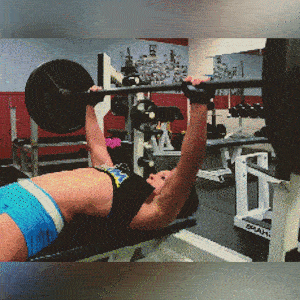
For the upper body, the bench press is one of the best exercises to be doing.
It’ll hit all the muscles on the front side of the body and is an excellent strength building exercise.
You can also do many variations of this one including incline bench press, decline bench press, as well as use both dumbbells and barbells for variety.
Some women mistakenly believe doing a bench press is going to decrease the size of their breasts, however note that the only thing that does that is getting down to a very low body fat percentage.
By doing bench press, you’ll actually help tighten the muscles underneath the fatty tissue that forms your breasts, which can create the look of better cleavage. It’s one exercise not to avoid.
Muscles utilized: Chest, Shoulders, Triceps, Biceps, Core (to a small degree)
How-To
- Position yourself in a flat bench, back down, and place both hands up on the barbell above you. Use a shoulder width grip.
- Press the barbell up until the elbows are extended but not locked.
- Keeping the back pressed into the back pad, lower the barbell down until it’s almost touching your sternum. Pause and then press back up to complete the rep.
6. Shoulder Press
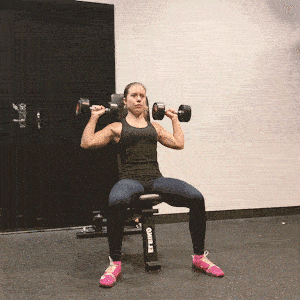
To really develop strong, well developed shoulders, try the shoulder press.
This move is a primary strength builder for this muscle group and can be done with both a barbell as well as a set of dumbbells.
You can also do it seated for maximum strength or if you want to incorporate more of your core, standing as well.
To learn how to get wider shoulders, see our article here.
Muscles utilized: Front Delts, Lateral Delts, Triceps, Biceps, Core (if standing)
How-To
- In a seated position, hold two dumbbells resting on your thighs.
- Next, ‘kick’ those dumbbells up (or bring them up yourself) until they are resting just above shoulder height. Elbows should be tucked in, back straight.
- Begin to press the dumbbells up over your head, extending the elbows but not locking.
- Pause for a second at the top and then lower the weight back down to complete the rep.
7. Rows
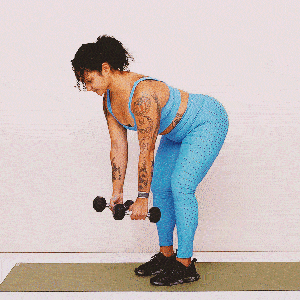
After hitting your chest and shoulders, you now have to work on your back. Some women tend to neglect their back because it isn’t a muscle group they see every day, but having a strong back is vital.
It’ll not only help prevent back pain down the road, but also help to prevent your shoulders from rounding as your pecs grow from doing your chest workouts.
Bent over rows can be done with just one hand using a set of dumbbells, both hands using a barbell, or you can use one of the weight machines and do horizontal rows or cable rows if you prefer.
Muscles Utilized: Latissimus dorsi, Trapezius, Rhomboids, Biceps, Posterior Deltoid, Core
How-To
- Assume a standing position with a barbell down in front of the feet
- Bend the back until it’s at a 90 degree angle, keeping the knees relatively straight (a slight bend is permitted).
- Reach down and grab ahold of the barbell using a shoulder width grip pattern.
- Pull the barbell up towards the chest, keeping the back flat and avoiding using momentum to hoist the weight up.
- Pause when it’s as high as it can go and then lower back down to complete the rep.
8. Pull-Ups/Lat Pull-Down

When working your back, you want to aim to do an equal amount of horizontal pulling exercises with vertical pulling exercises. If you do too much of one and not enough of the other, a strength imbalance may exist.
To counteract your rowing exercises, turn to pull-ups or lateral pull-downs. You can use these rowing machines if you are on a budget.
These exercises are great for giving you a bit of a broader appearance towards the shoulders, which in turn will help create the illusion of a slimmer waistline - something almost every woman desires.
Muscles utilized: Latissimus Dorsi, Rhomboids, Trapeszius, Posterior Deltoid
How-To
- Grab a hold of an overhead bar, hands placed slightly wider than shoulder width apart.
- Bend the knees slightly and keep the body in a straight, vertical line. Begin to contract the back and arms as you pull the body up to the bar.
- Pause when you reach the top and then slowly begin lowering again to complete the rep.
- Continue on until all reps are completed.
- Note you may do this in an assisted pull-up machine if necessary.
To give you more stability, you may use a weight dip belt, too, as you do this exercise.
You may also like our guide on advanced exercises and workouts for building bigger arms.
9. Plank Hold
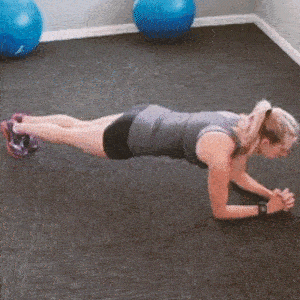
Finally, to finish off your body, you need a core exercise. The plank is an excellent go-to.
This exercise is unlike others in that it is an isometric hold, meaning you aren’t actually moving while doing the exercise but rather, holding one position in place.
The longer you can hold this, the stronger your muscles are.
Muscles utilized: Rectus Abdominis, Obliques, Transverse Abdominis, Delts (to some degree for balance), Glutes (for stability)
How-To:
- Get down on the ground and balance your body weight on your forearms placed directly below the shoulders and your toes, balancing on the floor.
- Keep the body straight and flat at all times while contracting the abdominal core.
- Balance here for 30 seconds or longer – as long as you can go while maintaining good form.

So there you have a closer look at the main compound exercises you should be including in your workout routine. Do keep in mind that this list is by no means exhaustive, but rather a brief overview of the most effective moves to get into place.
Once all these compound exercises are in place, you can thenbegin to add some of the isolation exercises noted earlier including moves like leg extensions, hamstring curls, bicep curls, overhead tricep extensions, lateral raises, and so on.
Proper Intensity When Training
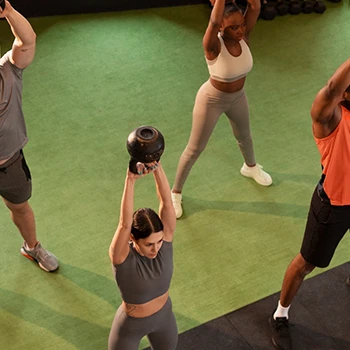
Through my practical knowledge, I understand the importance of applying an overloading stimulus for effective weight training.
This means subjecting them to more stress than they've ever experienced before.
You do that by raising the intensity of the workout session.
The intensity of a workout can vary greatly depending on individual goals and physical capabilities, but it is important to listen to your body and adjust intensity levels as needed to avoid injury and ensure a safe and effective workout.
As Hilary Topper — certified USA Triathlon Coach, RRCA Certified Coach, and personal trainer — puts it, "every woman is different, and intensity can vary depending on what you're hoping to get out of your workout."
Topper suggests moderate-intensity programs for those looking to improve overall fitness but for those whose goals require more intense strength training (like building muscle or increasing power), then it's usually necessary to work with a higher intensity.
There are three ways you can do this are the following:
- Rep - If you are looking to build lean muscle mass, you’d be looking at 8-12 reps. If you can currently do 8 at your given weight level, next workout, you’d try and get to 9. Then 10, then 11, then 12. Once you can do 12 reps, you are then ready to move into the next higher weight level.
- Sets - to boost intensity, simply add more sets. Start with two sets per exercise and then work your way to doing 3. Ideally, you should be aiming for between 20-30 sets per workout session. Start at the lower end of this and work your way to the higher end. Once you are at the higher end, it’s time to increase the weight or change your rep range.
- Rest - Ideally you’ll want your rest period to last for around 30-60 seconds if your goal is muscle building/shaping and 60-120 seconds if your goal is strength improvement. To add more intensity through rest times, decrease how much total time you spend resting between each set.
By continually changing things around and looking for new ways to force the muscles to keep working hard, you will ensure you don’t hit a progress plateau. Now, let's read more below about the workout routines that you can follow.
Strength Training Workout Routines
The next step in formulating a smart workout program is looking at your overall workout week. How will you be structuring your program in terms of each session you do? There are a few ways you can go about this:
- Workout option #1 - Full body workouts
- Workout option #2 - Upper/lower workouts
- Workout option #3 - Push/pull/legs workouts
Option 1. Full Body Workout
Full body programs are great for beginners as well as more advanced trainees as they really focus on strength development.
As you will be using so many compound exercises as well, they’re also great for fat loss purposes.
With the full body workout, as you are hitting every muscle group in each session, you’ll find you have little room for isolation exercises, so compound moves will be the primary focus.
Note that you’ll want to do at least two full body workouts per week, ideally doing three total.
Option 2. Upper/Lower Workout
The upper/lower workout program is where you will break the body up into halves, working the upper body workout for women twice per week and the lower body twice per week.
You’ll usually do two workout days in a row, take one day off and then take two days off for recovery before finishing up the week.
This type of protocol is great for those who want to specialize a little more on each muscle group as you can do more total exercises per muscle group compared to a full body workout session.
It’s also good for those who want to spend a little more time in the gym, doing four days per week instead of two or three.
Option 3. Push/Pull/Legs Workout
If you want to break things down even further you can then look into a push/pull/legs routine.
This divides the upper body into pushing movements and pulling movements, allowing for an even greater focus on each individual muscle group.
With this routine, you have the choice of either performing three workouts per week (one session of each), or doing four to five workouts and simply picking up the following week where you left off.
Consider your own recovery ability and time availability when determining how you will structure this one.
Benefits of Strength Training for Women
According to a study published by the National Institutes of Health (NIH), strength training has numerous benefits for women, including increased strength and improved musculoskeletal pain and body composition. Even slight to moderate amounts of exercise can increase women's strength significantly in just a few months [2].
Some of the benefits are the following:
- Experience a boost to your resting metabolic rate, making fat loss or weight maintenance that much easier
- Increase your functional strength, ensuring you can complete all of life’s daily tasks with ease
- Boost your energy levels – no more crashing at 3pm
- Improve your mood and confidence levels
- Strengthen your bones and prevent osteoporosis down the road
- Increase your heart health
- Improve your balance and agility, which transfers over into any sports you may participate in
- Completely transform your body, adding shape and curve exactly where you want it to be
Women VS Men: Strength Training
Based on my first-hand experience, women's strength training needs differ from men's due to physiological differences. My research in this area demonstrated that women may require different exercise intensities and recovery periods.
- Women typically are not naturally as strong - You still need to challenge yourself to the limit. While your male gym partner may hoist the 50 pound dumbbells and feel challenged by it, you might use the 15 pound dumbbells and feel the same degree of challenge.
- You may not recover quite as well - Men tend to bounce back between sessions faster and can handle more workout volume. This is again thanks to that higher level of testosterone they have. So while he may do 4-5 sets per exercise, you may only do 3. It’s a minor change, but an important one to note.
- Women will need to employ shorter rest periods for fat loss purposes - Things like superset, drop sets, and circuit training will help give your metabolic rate a bit more of a boost and help you tap into the stubborn body fat stores. Men generally do lose weight more easily than females do, so these techniques will help give you a bit of an edge. See our top 10 exercises to lose weight.
On the aerobic side of things, men tend to be slightly faster than women with equivalent levels of training. However, the difference is almost entirely explained by body composition differences (men tend to be leaner), hematocrit differences (higher levels of testosterone lead to slightly higher red blood cell counts), and differences in heart size.
- Greg Nuckols, Stronger by Science
FAQs
How Many Times Should I Be Strength Training per Week?
I would say a minimum of three times per week if you want to see results. You can reduce it to two times per week if you're just starting out or if you're just looking to maintain. You don't need to spend 2+ hours at the gym. You can spend up to 30 min at the gym and still see results - just make sure that you're pushing yourself. However, we recommend a minimum of 45 minutes at the gym.
What if I Miss a Workout? Should I Do It the Next Day?
If it’s a full bod workout, just pick up where you left off. If it’s an upper/lower split, you could do the workout you missed provided you are not going any more than 3 days in a row with exercise (until your next workout session). When in doubt, just pick up where you left off.
What if My Knees Always Seem to Hurt When I Work My Lower Body?
Make sure that you are moving your toes directly over your knees while doing your exercises to help prevent leg pain. And, avoid leg extensions. This exercise can be very stressful on the knee joint.
Should I Do Cardio on My Weight Training Days?
I recommend doing it on the days you're not working out as you want all the energy when workout out, so do your cardio on your off days. Here's our guide on the difference between cardio and strength training.
Should I Train to Failure?
Not every workout. While you can train to complete failure (keep going until you do that last rep without completing it) once in a while to really push yourself, training to absolute failure every workout will lead to fast burnout.
Do I Need to Eat Before I Do a Weight Lifting Workout?
Yes, you should be consuming a light meal of around 200-250 calories 60-90 minutes prior to your weight lifting workout. This meal should consist of both protein as well as carbohydrates.
References:
- www.ncbi.nlm.nih.gov/pmc/articles/PMC3820232/
- www.ncbi.nlm.nih.gov/pmc/articles/PMC5523796/
About The Author
You May Also Like



